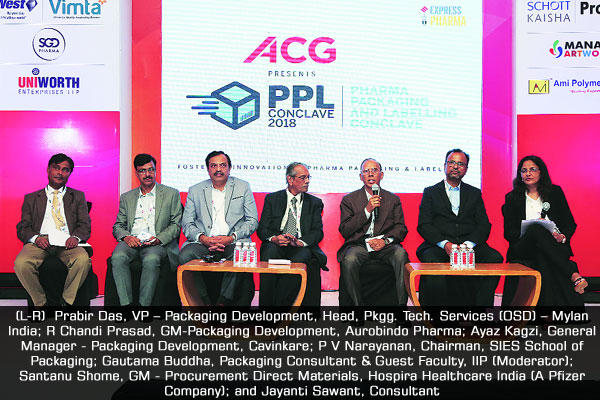PPL Conclave 2018 comprised several insightful and interesting panel
discussions. The first panel at the conclave focussed on the buzzword in every industry
today – innovation. An eminent panel comprising Gautama Buddha, Packaging Consultant & Guest Faculty, IIP; Prof PV Narayanan, Chairman, SIES School of Packaging; R Chandi Prasad, GM-Packaging Development, Aurobindo Pharma; Santanu Shome, GM – Procurement Direct Materials, Hospira Healthcare India (A Pfizer Company); Jayanti Sawant, Consultant; Ayaz Kagzi, GM – Packaging Development, Cavinkare and Prabir Das, VP – Packaging Development, Head, Pkgg. Tech. Services (OSD) – Mylan India conversed and conferred on strategies needed to foster an ecosystem conducive for pharma packaging innovation.
Buddha, as a veteran of this industry and the moderator for this panel, posed several
pertinent questions to the panelists to drive meaningful dialogues and gain their
insights. He questioned them on the prerequisites to create an ecosystem where innovation thrives, the role of academia in nurturing such an environment, role of important partnerships, so on and so forth.
R Chandi Prasad opined that a constant flow of communication and interaction between different stakeholders is a must to encourage innovation in pharma packaging. He recommended the academia, research organisations and user industries to collaborate and facilitate innovation.
Prof Narayanan touched upon a variety of topics such as academia’s role in furthering
innovation, cost optimisation with packaging, its role in controlling the spread of spurious medicines etc. He spoke on the creation of pharma packaging exclusive approval centres as extensions of existing institutional facilities. He urged pharma packaging professionals to keep pace with changing regulatory requirements .
Shome spoke on the benefits of building successful partnerships to develop a culture of
innovation. He cited examples of Pfizer’s efforts in this direction. He informed that the company has an innovation team for each function. Likewise, he also spoke on the
company’s partnership with Merck and Corning to drive innovative solutions.
Das elaborated on the benefits of an ecosystem such as creating a unique identity,
gaining a competitive edge, cost benefits and so on. He also cited examples to prove his point. For instance, a small design innovation helped his company to safeguard a product more effectively and, at the same time, save costs in the long run.
Kagzi spoke on how the pharma industry should look at the measures taken by the rest of the sectors to learn, adapt and adopt from them in a bid to provide more value through packaging. He also said that innovation should enhance the experience of the patient and these are things that the industry should work to develop.
Sawant advocated the need for continuous review of packaging systems and processes to enhance their performance and plug the loopholes. She also said that people and processes, both have to be selected carefully to create an innovative ecosystem.
The panel discussed on the newer methods of packaging and their ability to serve different needs and populations. They were unanimous in their view that each company should invest more in packaging R&D and create an innovation funnel to spur their growth trajectory. The panelists also reflected on the enormous potential of IT and ICT systems to drive innovation in this industry.
Key takeaways:
- Academia, research institutes and user organisations should collaborate to drive innovation
- Every pharma company should create an innovation funnel, even in the packaging segment to drive growth
- Technology is a great enabler in fostering an ecosystem for innovation
- Advertisement -



Comments are closed.